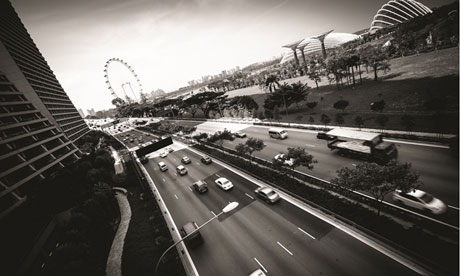 |
| Bogota transport Photograph: Alcadia Mayor de Bogota |
"Cities are where the greatest climate change challenges and opportunities lie, and where mayors are pioneering initiatives
Efforts by national governments to tackle climate change and other sustainability
challenges have been mixed at best over the past 20 years, but there is
one level of government that has embraced the challenge with gusto –
and success.
"National governments have largely failed to act, while cities
embody the spirit of innovation we need. When it comes to climate
change, cities are where the most exciting progress is being made," said
Michael Bloomberg, mayor of New York, speaking by videolink to the City
Climate Leadership Awards in London this month. He added pointedly
that, "mayors do not have the luxury of just talking about problems.
They have to deliver results."
Partly, this is a matter of
necessity – more than half the world's people live in cities, they
consume two-thirds of the world's energy and generate 70% of carbon
emissions. "If we want to win the war against climate change, it has to
be won in cities," said Roland Busch, head of Cities and Infrastructure
at Siemens, sponsors of the awards.
Many of the world's megacities
are situated on the coast and their vulnerability to sea level rise and
the effects of extreme weather events has been highlighted in recent
years by disasters such as Superstorm Sandy, which devastated New York last year and Hurricane Katrina,
which had a similar effect on New Orleans. But it's not just rising
seas – each city has its own challenges, from the wildfires that
threatened Melbourne in 2009 to the floods that deluged Bangkok in 2011,
severely disrupting the entire Thai economy, to the choking smog that
afflicts Beijing, New Delhi and Los Angeles.
But equally, the
world's urban areas are where the opportunities lie – they generate more
than 70% of global GDP and cities are growing faster than other parts
of the economy. "If you want to provide infrastructure for people in the
most cost-efficient and effective way, you do it in cities," said
Busch.
Perhaps the fact that people in urban environments are
"squished together" makes them more accepting of the need to take
action, said Matthew Pencharz, an adviser on energy and environment to
London's mayor Boris Johnson. While national politicians' pronouncements
can sometimes seem too vague for people to get to grips with, "mayors
have found a way to take action that is accountable to the population
and brings them visible, tangible benefits that improve their quality of
life."
Mayors have a lot of the right power, argues Rohit
Aggarwala, special adviser to the C40 Cities Climate Leadership Group
and former director of planning and sustainability in New York. "The
politics align well and, in addition, many of the interest groups that
are most opposed to climate action are simply not as prominent in
cities."
The consultants McKinsey argue in a new report
entitled How to make a city great, "that leaders who make important
strides in improving their cities do three things really well: They
achieve smart growth. They do more with less. And they win support for
change."
These improvements do not need to cost a lot of money if they are
imaginative enough – McKinsey reports that the former mayor of Bogotá,
Antanas Mockus, "famously hired 420 mimes to make fun of traffic
violators: this entertaining public ridicule reduced traffic fatalities
by more than 50%."
Robert Doyle, Lord Mayor of Melbourne,
explained how his city has a plan to double the number of trees in the
city by planting an extra 30,000 saplings, which he said would cut
temperatures in the centre by 4°C, as well as making the city more
liveable and sustainable.
 |
| Singapore transport Photograph: Land Transport Authority of Singapore |
Other initiatives are more complex and
all-encompassing – Tokyo won the finance and economic development prize
at the awards for introducing the world's first city-based carbon
trading programme, which since its introduction in 2010 has cut the
Japanese capital's emissions by 7m tonnes by focusing on emissions from
buildings.
Meanwhile, Singapore's Intelligent Transport System, which
incorporates a range of smart transportation technologies and allow the
city state to enjoy one of the lowest congestion rates of a city its
size anywhere in the world, was awarded the Intelligent Infrastructure
Prize.
The old days, when the various aspects of city life were
tackled separately, are gone, according to Busch. "A city is like a
human organism – everything has to work together. A comprehensive view
of infrastructure, disregarding silos, is the key to the future
development of cities."
And while every city is different, they
can learn a lot from each other about what works best – and they are
prepared to do so, in a way that national governments do not seem to be.
That is why Boris Johnson, opening the awards, said that whoever won
the awards, "you can be sure that we in London will shamelessly nick
your ideas".
One of the lessons cities have learned is the
importance of measuring their impacts. "If you know where to start, then
you know where to go," said Busch. One example of this is the decidedly
chilly city of Oslo in Norway, which discovered that along with heating
in the winter, cooling buildings in summer was a significant source of
emissions. "We were surprised," said mayor Stian Berger Røsland, "but it
enabled us to look at using seawater for both heating and cooling."
By
refusing to wait for action from national governments and international
bodies, cities are leading the way in addressing the risks posed by
climate change, said Bloomberg. "Using innovative local approaches,
cities are having an impact on climate change globally.""









Sem comentários:
Enviar um comentário